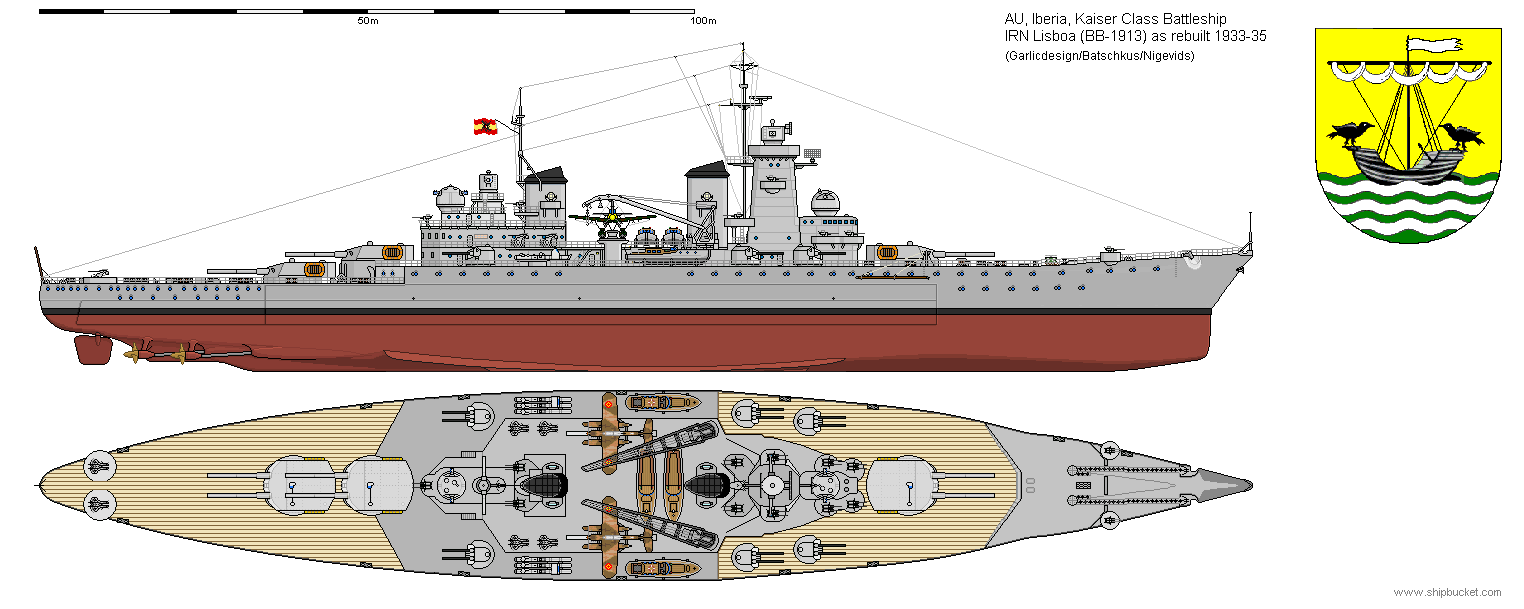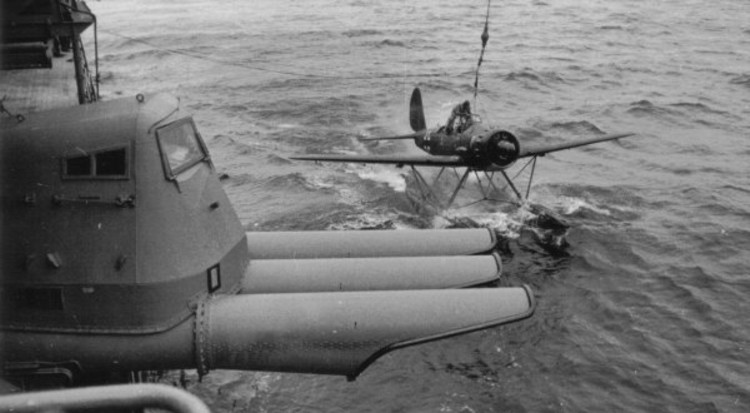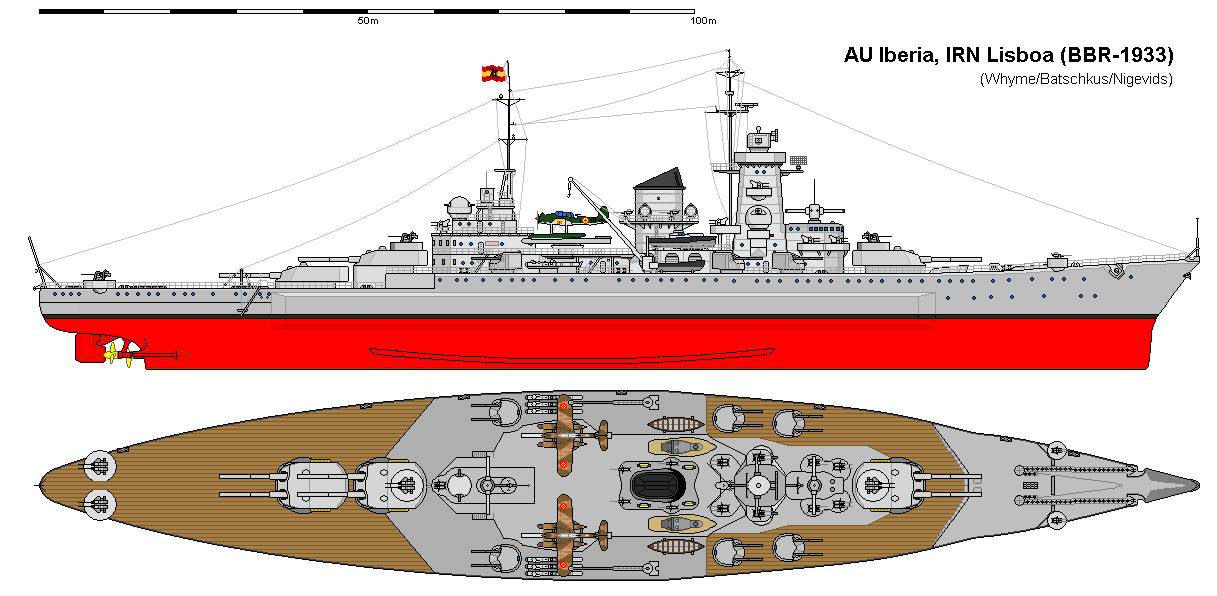IRN Lisboa (BB-1913 (BBR-1935))
Return to Iberian Navy page:
The Germanic States had always had long range raiders in their minds for
overseas merchant warfare. The five Kaiser class battleships were perfect for
conversion to long range raiders that would partner the Admiral class
battlecruisers that had been built for the same duties. The only problem was
that the five Kaiser class ships had been dispersed with the Germanic States
loss of WW1. The Germanic States had retained three, while Iberia had purchased
two from the Allied War Reparations Commission. The Germanic States were happy that the
ships had gone to a country that they had a good association with. In 1931 the
Germanic States started converting their three Kaiser class ships to long
range raiders. In 1932 the Iberian Naval Attaché was invited to look at the ship
and plans with the offer of technical assistance in converting the Iberians
ex-Kaisers. Telegrams flew between the interested parties with the outcome being
the Iberian acceptance of help with the conversion of their nearly 16 year old
ships.

Displacement: 25,400 tons normal displacement, 27,100 tons full load
Dimensions: 580 x 97 x 30 feet
Machinery: 4 shaft turbines, 42,000shp
Speed: 22 knots
Endurance: 7,500 nmi at 12 knots
Armour: 350mm (13.75") belt, 30mm (1.2") deck, 300mm/170mm/105mm turrets
Armament:
10 x 12" (5x2)
14 x 5.9" (14x1)
10 x 88mm AA (10x1)
Torpedoes: 6 x 500mm (6x1 underwater)
Crew: 1100 (1175 as Flagship)
To provide the long range and cruising speed necessary for the long range
raiders required the removal of the B and X turrets, handling rooms
and magazines. The three remaining turrets are refurbished to enhance the range
out to 30,000 yards. While the old deck armour is up to replace the powerplant, the
chance is taken to improve the deck armour to 105mm thickness. New bridge
structures, aircraft handling facilities, new secondary, tertiary and AA
armaments are fitted into the space provided by the removal of the turrets. The old engines and boilers also are removed and replaced with
modern steam and diesel propulsion to raise the speed of the ships to a rate
where the older French, British and American battleships would not be fast
enough to catch them. This premise is processed through the late 1920's and
early 1930's and so did not take into account the aircraft carrier and fast
battleship. Though there were not enough aircraft carriers available for search
duties at the start of the war for the size of the search area.

Displacement: 26,500 tons normal displacement, 32,200 tons full load
Dimensions: 607 x 97 x 30 feet
Machinery: 4 shaft, geared turbines
105,000shp
Speed: 29 knots
Endurance: 10,000 nmi at 15 knots
Armour: 350mm (13.75") belt, 105mm (4.1") deck, 300mm/170mm/105mm turrets
Armament:
6 x 12" (3x2)
12 x 4.5" (6x2)
12 x 37mm (6x2)
26 x 20mm (13x2)
Torpedoes: 6 x 21" (2x3)
Aircraft: 2
Crew: 1150 (1220 as Flagship)
IRN Lisboa (ex-Prinz Regent Luitpold-1913) Lost
IRN Madrid (ex-Koenig Albert-1913) Lost

The fourteen 5.9" secondary guns were replaced, one deck higher, with the
dual purpose 4.5" weapons. Three dual purpose directors were fitted to direct
the fire of these guns. One main and two secondary directors were fitted for the
12" guns which was very useful when in amongst a convoy of merchantmen as the
three turrets would have one director each and would fire at independent
targets. A heavy AA battery showed where the ships thought their main threat may
come from. To aid the ships own search capabilities a pair of spotter aircraft
were fitted. There was no hangar for the aircraft (there not being enough space
for one) so aircraft maintenance was carried out on the aircraft in the space
aft of the funnel where there was enough space for the air-mechanics to be able
to walk around the aircraft. This meant that one aircraft had to be on its
catapult, while the other was under maintenance. During the early part of the
war the raiders were hard to find.
It is easy to forget (with modern technology) that a ship by itself, with no
radar or own aircraft, is limited to the vision range from the highest spotting
point on the ship. Depending on visibility this would be a range of 15-20 miles.
On a 1 meter map of the world, that would not even be a pin prick. Radar might
go out to 40 miles, still no pin prick. Own aircraft or from a carrier raises
the search area considerably maybe as much as 150 miles from base and greatly
increases the chances of interception (maybe a 1-2mm circle on map). Land based
airpower with its greater range keep the raider from enemy coast lines. Any
raider commander just has to draw the appropriate circles on the map as to where
land airpower can reach and the rest of the map is his to play hide and seek in.
The Iberian ship was converted to a different plan than the Germanic States
ships (See Kaiser). Being started
slightly earlier the GS ships kept the secondary - tertiary gun arrangement of
5.9"(LA) and 88mm(HA) where the Lisboa had dual purpose weapons. The other
divergence was in the propulsion units, the GS units had the mixed diesel and
turbine installation where the Iberian ships had turbines only. The Iberian
ships were to be used in the Central Atlantic and Western Mediterranean, their
natural areas of influence. Those areas did not require the extra long range of
the GS ships hence the turbines only.
Original drawings and details of the real time line Kaiser class and the
raider upgrade drawing I did for them.

| Displacement |
24,400 tons std, 27,250 tons full load |
25,500 tons std, 30,800 tons full load |
| Length |
580 ft |
587 ft |
| Breadth |
97 ft |
97 ft |
| Draught |
30 ft |
30 ft |
| Machinery |
3 shaft turbines, 42,000shp |
Geared turbines 100,000shp |
| Speed |
22 knots |
28 knots |
| Range |
8000 at 12 knots |
17,000 @ 15 knots |
| Armour |
13.75" side, 1.2" deck, 12-4.1" turrets |
|
| Armament |
As built 10 x 12" (5x2)
14 x 5.9" (14x1)
12 x 88mm (12x1)
|
As rebuilt 6 x 12" (3x2)
12 x 4.5" (6x2)
8 x 37mm (4x2)
44 x 20mm (9x4 2x2 4x1) |
| Aircraft |
nil |
2 |
| Torpedoes |
5 submerged |
6 x 21" (2x3) |
| Complement |
1200 |
| Notes |
IRN
Lisboa |

Return to Iberian Navy page:

